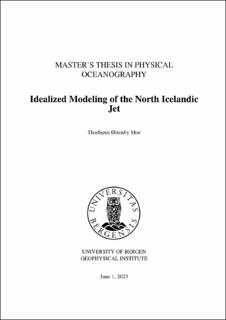Idealized Modeling of the North Icelandic Jet
Master thesis
Permanent lenke
https://hdl.handle.net/11250/3071890Utgivelsesdato
2023-06-01Metadata
Vis full innførselSamlinger
- Master theses [123]
Sammendrag
The North Icelandic Jet (NIJ) is a crucial component of the lower limb of the Atlantic Meridional Overturning Circulation, supplying one-third to one-half of the overflow water transport through Denmark Strait, including the densest portion. However, the mechanisms associated with its emergence, evolution, and structure are not fully known. With an idealized model of the north Icelandic slope developed using ROMS, I study the fundamental dynamics of the NIJ, including the mechanisms governing its formation. I designed the model as a channel along the slope north of Iceland, initially with no external forcing. Several specific boundary conditions were then iteratively applied to the western boundary, intended to simulate combinations of Atlantic inflow and dense outflow through Denmark Strait. Additionally, configurations with differing levels of increased realism regarding both hydrography and changes in slope steepness in the along-channel direction were simulated. My simulations are consistent with the cross-sectional structure observed north of Iceland, including a mid-depth intensified NIJ associated with diverging isopycnals away from the slope. I have found that the simulated NIJ is the strongest and most consistent when prescribed to the bottom and adjacent to a strong Atlantic inflow, indicating the importance of the flows through Denmark Strait for the upstream structure. The current’s stability and strength are considerably reduced with a steeper north Icelandic slope, indicating that slope steepness heavily influences the NIJ. Along-channel changes in slope steepness show an uncoupling of the strength and structure of the simulated NIJ, as the structure is largely determined by the steepness, while the strength depends more on upstream modifications. Along- and across-channel changes in the stratification are found to have a smaller impact on the general structure and circulation than the slope steepness. Higher EKE associated with the steeper slope in my simulations corroborates that the northeastern Icelandic slope is a crucial region for the emergence of the NIJ.
